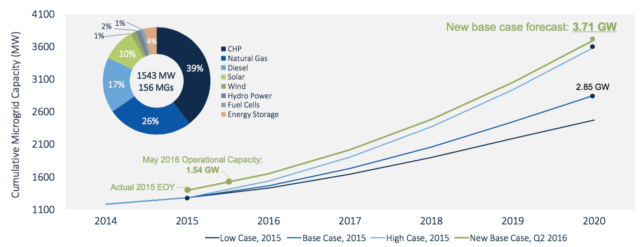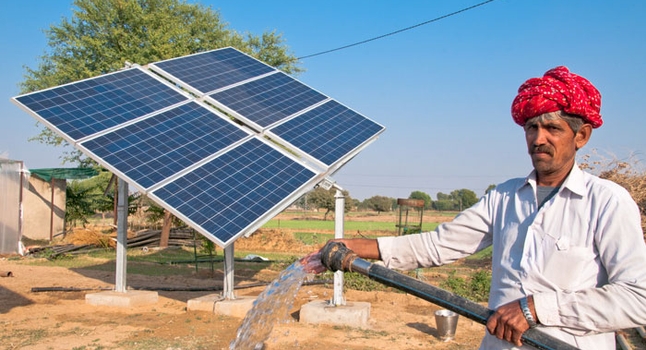>> Microgrids
– GTM Ups 2020 Microgrid Capacity Forecast 30%

U.S. microgrid capacity will increase faster out to 2020 than forecast last year, rising to 3.7 GW by 2020, according to GTM Research’s Q2 2016 market research update. That’s 30 percent higher than GTM predicted in its 2015 market forecast.
GTM tracked 237 microgrid projects in the U.S. in Q2. The total included 156 operational microgrids with rated power capacity of 1,543 MW and 81 other projects in the planning stages.
More than half (55 percent) rely or are to rely on fossil fuels. Renewable microgrids will account for 45 percent. To date, operational renewable microgrids account for 14 percent of cumulative operating capacity, more than double the 6 percent reported one year ago.
GTM highlights four key trends it expects will play a large part in determining microgrid growth path going forward:
- Enhanced reliability continues to be a major driver at the federal and state levels, particularly in the Northeast.
- Attractive business models rely on co-ownership agreements.
- Technology vendors are building their microgrid controls and energy management specialization.
- Both regulated and unregulated utilities are planning for microgrids. Regulated utilities are developing public purpose projects, while deregulated utilities target C&I customers.
– SunPower to Install Microgrid-Ready Solar at Alabama Army Post
SunPower is poised to begin construction of a 10-MW microgrid-ready solar power plant at a U.S. Army post in Alabama this month. The Silicon Valley-based integrated solar manufacturer/developer is in charge of building the solar microgrid for the Redstone Arsenal U.S. Army post per the terms of a 27-year power purchase agreement (PPA).
The contract marks the first PPA project solicited through a Department of Defense (DoD) renewable and alternative energy Multiple Award Task Order Contract (MATOC). Installation of a SunPower Oasis Power Plant system is expected to generate as much as 18,000 MWh/year of emissions-free energy.
The Army has set a goal to secure 25 percent of its needed energy from renewables by 2025, and is planning to install 1 GW of renewables on Army installations, according to the news report.
– Wind-powered Microgrid for Iowa
A wind-powered microgrid is being built on farmland south of the town of Huxley, Iowa, according to a news report. The U.S. subsidiary of Italy’s Building Energy is installing two 3 MW Acciona wind turbines on just 1.25 acres of farm land owned by two Huxley families at an estimated cost between $2.5 million to $3 million each.
The wind-powered microgrid system will dispatch electricity to Alliant Energy’s grid and be able to operate independently of the grid in the event of power outages. It’s projected that each will generate enough emissions-free electricity to power some 980 homes in the local community.
“I think it’s a really cool project,” says landowner and local physician Kirk Peterson. “The more research I do about it, the more excited I am about the whole thing.
“Microgrid wind farms have become a viable solution to supply energy to local communities, because the power generated by the turbines ties directly into the local distribution system…The biggest selling point for me to do this is that wind energy is clean energy. This won’t be power generated by a coal-burning plant somewhere. This will be wind … providing clean energy to local people.”
> International

*Tata Power
– ABB Installs Hybrid Solar-Diesel Microgrid in South Africa
ABB commissioned solar-diesel-fueled microgrid at its Longmeadow facility in Johannesburg. A 750 kW solar PV system was added to the facility’s existing diesel-fueled emergency power generation platform, along with a 1 MVA/380 kWh ABB PowerStore battery energy storage and regulation system and a Microgrid Plus distributed control system, according to a news report.
A cloud-based remote service system will be deployed to manage operations and maintenance. The project is right in line with ABB’s focus on capitalizing on its ¨Internet of Things, Services, and People¨ business development strategy.
¨This is a world premiere for the innovative solution with fully grid-connected and off-grid functionalities designed to maximize the use of renewable energy and ensure uninterrupted power supply to keep the lights on and the factories running during any planned or unplanned power outages on the main grid supply,¨ according to the news report.
– India Looks to Renewable Micro/Mini-grids for Rural Community Development
India’s Ministry of New and Renewable Energy (MNRE) this past week released a draft proposal to improve rural electricity access by facilitating private investment to build at least 500MW of renewable micro- and mini-grid systems. The envisaged clean energy microgrids will be powered by solar, wind, and/or biomass, according to a news report.
>> Solar Power
– Utility Rates Don’t Rise, and May Fall, as More Solar Power Comes Online
Worries of a power utility ¨Death Spiral¨ permeated industry news media last year. As per this hypothesis, rapid growth of distributed solar, wind, and other renewable energy generation capacity would render utility business models ineffective and irrelevant. In addition, consumers would bear the burden of higher-cost, less reliable grid power.
A new report from the Brookings Institution contends that to the contrary, utility rates would stabilize at lower levels amidst rising penetration of renewable generation capacity, and that utilities will be fine, as long as they prove capable of adapting to the new market and industry environment.
Under attack in various states, state government net metering policies have been keys to spurring growth in residential and commercial solar PV investment and deployment.
Contrary to utility and opposition politicos’ claims, utility business models are not being destroyed by being required to compensate solar and other distributed renewable energy ¨prosumers¨ at retail market rates for the electricity they supply to grids. Furthermore, residential solar PV isn’t benefiting the well-off and leaving the less well-off to shoulder rising grid electricity costs, according to Brookings’ study.
Brookings offers numerous examples of electric utility rates decreasing amidst growing penetration of residential solar PV generation capacity – in Maine, Massachusetts, Missouri and Nevada, for instance. The think tank attributes this decrease to several factors:
- Displacing the need for more expensive power sources;
- Reducing the need to build more power plants to meet peak electrical demand;
- Helping to stabilize the grid; and
- Helping meet state air quality standards.
The report doesn’t mean that utilities and their investors don’t face challenges as a result. The problem is that under current market regulatory frameworks, revenues and guaranteed minimum profits rise the more generation capacity utilities build and own. A strongly ingrained ¨business as usual¨organizational culture doesn’t make things easier, given an increasingly pressing need to adapt and innovate.
